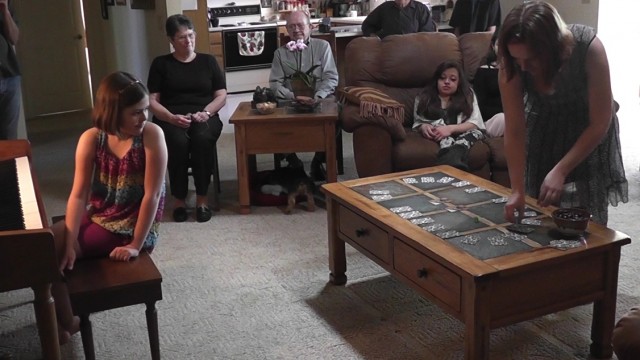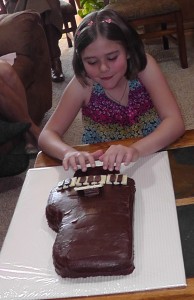
Today was the Suzuki Book 1 recital of a student of mine. She had been taking piano for a year and half, starting last year with my daughter, and moving to my studio this past fall after my daughter left for college.
Two of my Suzuki teacher trainer mentors from Ann Arbor, MI (Armena Marderosian and Renee Robbins) introduced me to the concept of Suzuki Book recitals. When a child has finished learning all of the songs in a Suzuki Book, they throw their own solo recital. In my studio, the recital is held in the home of the student, on their own piano. I encourage the family to invite friends, family, and fellow studio students. Usually, the parents treat it like a birthday party, complete with cake, snacks and beverages, and some small gifts. I typically bring a CD of piano music that I think will interest the child as a graduation gift, but I have been known to give other items, like the Harvard Dictionary of Music, or even a metronome to replace a less than adequate one.
I encourage families to take ownership of the Book recital and find a twist that makes it unique to them. Many students will keep the recital to the basics — a set of order of pieces with a program handed out to the audience members, but many other students rise to the challenge of making the recital even more fun.
Some of the twists of Suzuki Book recitals that I’ve witnessed in my studio include:
- Several families have written a story with the titles of the songs embedded in the text. When the title of a song comes up, the narration of the story stops so that the child can play that piece.
- Another family put on a play, complete with costumes, again with the song titles embedded in the text.
- One father surprised the child and created a mock game show, that included riddles and prizes. The answers to the riddles were the titles of the songs.
- Sometimes the titles of the song or hints to the song are written on scraps of paper thrown into a hat, and audience members get a turn to draw from the hat a scrap and read out loud the title or hint.
- One family listed the songs in a specific order on the program, but before each song, the brother of the student read a few words about the song that the student had written. These words might be an imagery the student had about the song, a reaction to the song (one of the was listed as her least favorite because … and I forget why), or even a parents’ reaction to the song (“Mom loved this song because …”). That was a particular touching recital, because it revealed personal relationships to the music.
Today’s recital revolved around a clever game that evolved from discussions over several lessons. There was a game piece (a plastic piano), a die, and 25 cards laid in a circle. There was a card for each of the 22 songs in Book 1 plus 3 extra cards for duets the child was to play with different people (one with me, one with her mom, and one with my daughter (her first teacher), who is home for spring break). Each person in the audience took a turn rolling the die, moving the piece to a card, reading that card’s hint out loud (e.g., “How you paddle a canoe” for “Lightly Row”), and then moving that card to the discard pile. Because the card was moved to the discard pile after being chosen, the game piece could only move to the remaining cards on successive turns. After playing the song, my student announced what the title of the song and (if necessary) recited some words to the songs she had learned so that the audience understood how the hint related to the song.
After the final piece was played (Honey Bee — “What Pooh always chased…”), Mom broke out a hand crafted piano cake for all to share.
The recital was quite charming, the audience was engaged, and my student played confidently and had a lot of fun.
Oh, and I gave my student a CD of Scott Joplin rags. I fully expect to be hearing about her favorite songs from that CD at the next lesson.

I love the idea of turning the first book into a story. Wonderful! Thank you for sharing!
You’re welcome!